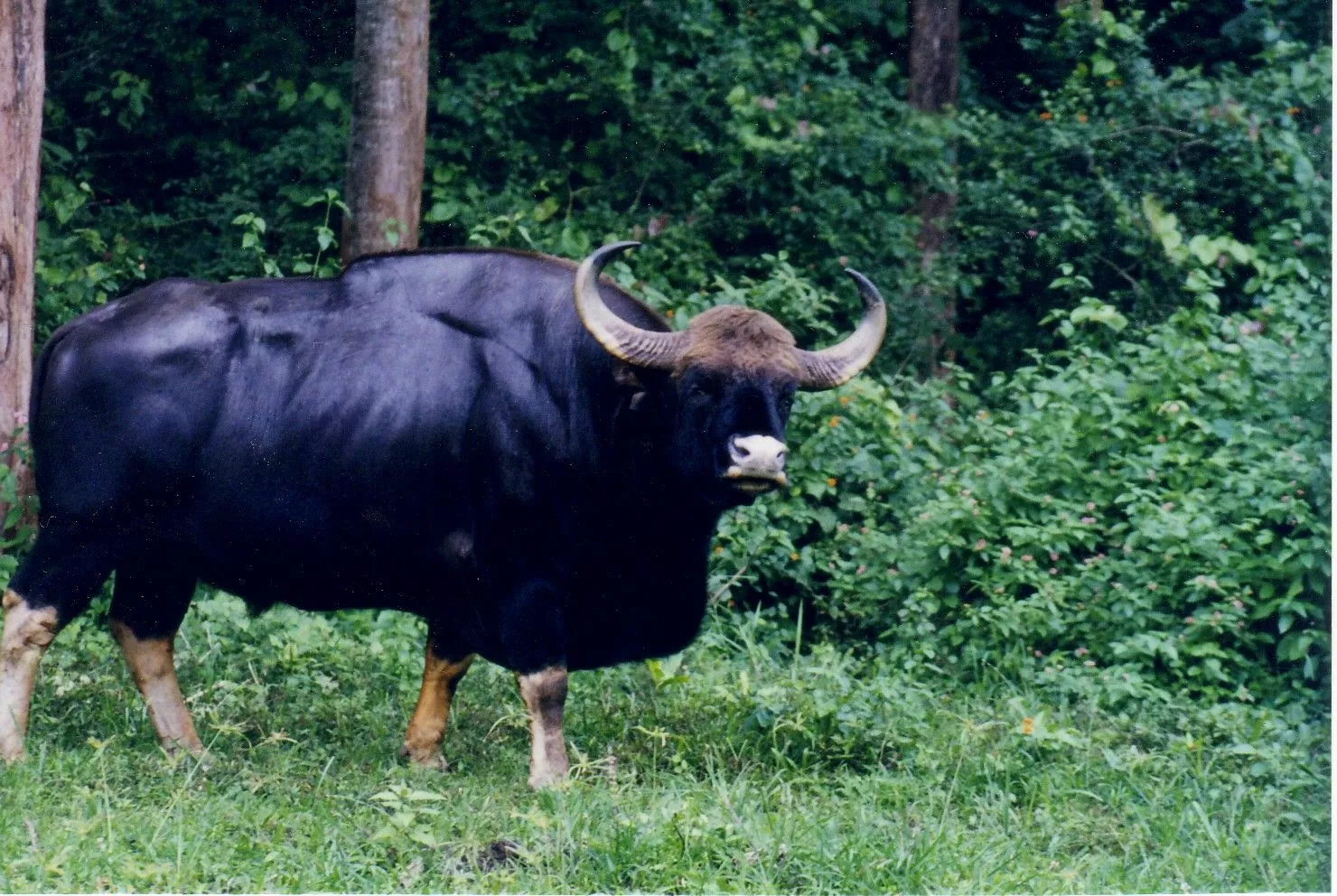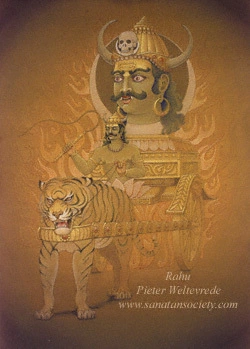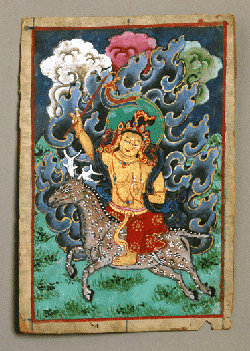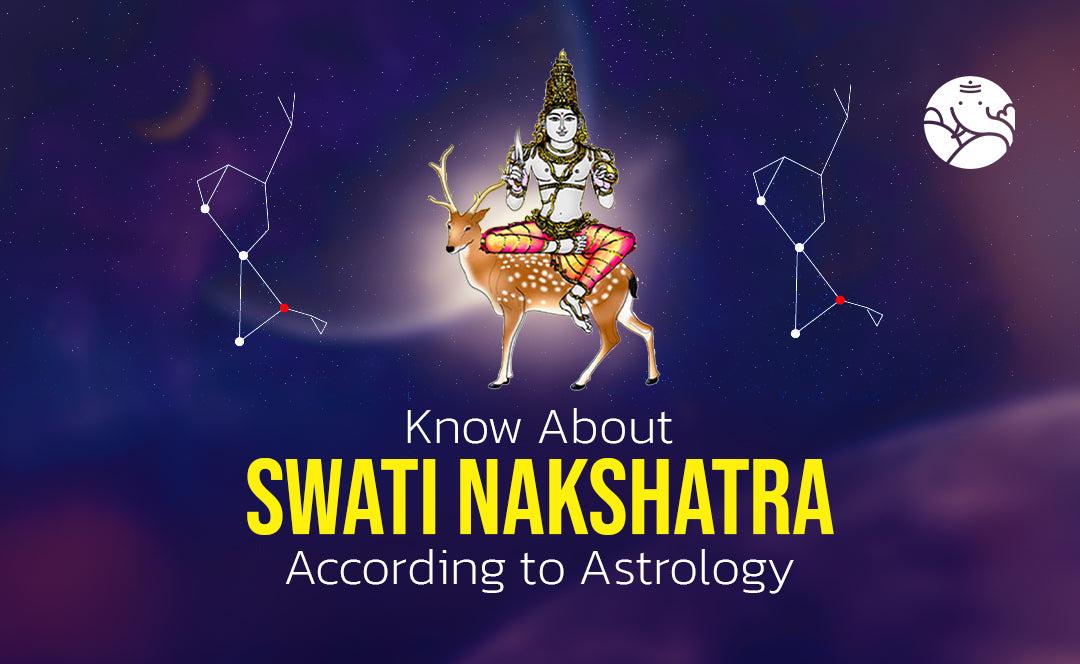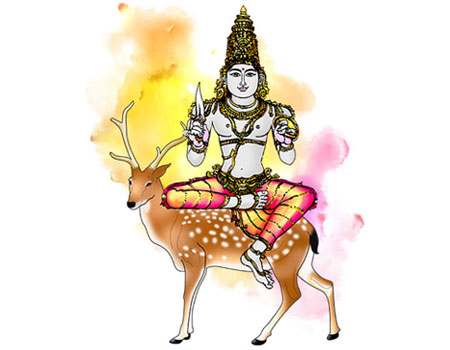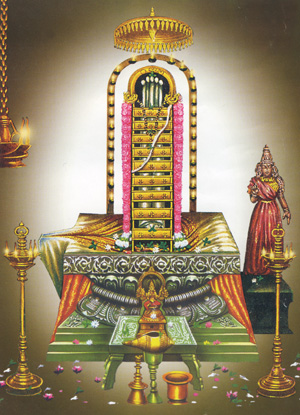
#Swati #Nakshatra is a powerful and ancient Indian astrological #constellation. It is the 15th Nakshatra and is associated with the planet #Rahu. People born under this Nakshatra are said to be highly ambitious, creative, and independent. They are also known for their intelligence, confidence, and leadership abilities.
इस पेज को हिंदी में पढ़ने के लिए स्वाति नक्षत्र पर क्लिक करें।
Swati Nakshatra is represented by the symbol of a blade of grass swaying in the wind, which reflects the nature of its ruling deity, #Vayu – the air god. It symbolizes the idea of flexibility and adaptability to changing conditions. Swati Nakshatra is a reminder of the importance of staying open to changes and being able to adapt to the new environment.
Swati Nakshatra is associated with the zodiac sign #Libra, which is ruled by the planet #Venus. People born under this Nakshatra are known to be balanced, diplomatic, and fair. They are also believed to be generous and compassionate. Swati Nakshatra is a powerful and influential star that can bring great luck and fortune to its native. It is important to understand the characteristics and powers associated with this star in order to make the most of its energies.
Swati Nakshatra is determined by the date of birth of the native and is believed to be one of the most important components of a person’s birth chart or kundli Swati Nakshatra covers the dates from October 23rd to November 21st. Those born during this period are said to have the qualities of the constellation Swati, such as intelligence, intelligence, creativity, and the ability to think on their feet.
The position of Swati Nakshatra in your birth chart is an important factor to consider. This position will determine how the energies of Swati will affect different areas of your life. Knowing the position of Swati in your birth chart can help you understand how to work with its energies in order to get the most out of them.
Swati Nakshatra Padas
Swati Nakshatra is one of the 27 constellations of the Vedic astrological system. The four Padas of Swati Nakshatra are:
Swati Nakshatra Pada 1: This Pada is ruled by Rahu and symbolized by an elephant tusk. People born in this Pada are believed to be full of energy and enthusiasm, often taking on projects that require a lot of hard work and dedication.
Swati Nakshatra Pada 2: This Pada is ruled by Shukra and symbolized by a sword. People born in this Pada are thought to be strong-minded and independent, and they often accomplish great feats of courage.
Swati Nakshatra Pada 3: This Pada is ruled by Chandra and symbolized by a fan. People born in this Pada are believed to be kind and gentle, often putting the needs of others before their own.
Swati Nakshatra Pada 4: This Pada is ruled by Budha and symbolized by a pearl. People born in this Pada are thought to be wise and analytical, often taking the time to carefully consider their decisions.
Characteristics of Swati Nakshatra in Vedic Astrology
Swati Nakshatra is one of the most powerful and influential Nakshatra in Vedic astrology. Represented by the mighty peacock, Swati is known for its adaptability, intelligence, creativity, and independence. Those born under this Nakshatra are naturally creative and independent, and they are driven by the need to express their unique personal vision. Swati natives are ambitious and highly motivated, and they can be very successful in whatever they do.
They are also highly intuitive and can often sense the emotions and motivations of those around them. They enjoy being in the spotlight and are often quite extroverted. Swati natives are also very loyal and caring towards their loved ones. They are also deeply spiritual and often look to the stars for guidance. They are usually quite determined and have a strong will to succeed.
Swati is a powerful and influential Nakshatra, and those born under it can be very successful in whatever they do. They are driven, independent, and creative, and often rely on their intuition to guide them through life.
Characteristics of Male Swati Nakshatra
The Male Swati Nakshatra is known for its distinctive qualities, which can be summed up in the following points:
Authority: Male Swati Nakshatra individuals are known for their natural authority and leadership skills. They have a strong sense of responsibility and are often sought after for their guidance and advice.
Intelligence: Male Swati Nakshatra individuals are highly intelligent and often have an impressive knowledge base. They are excellent problem solvers and thrive in challenging situations.
Communication: Male Swati Nakshatra individuals have excellent communication skills, both verbal and written. They are able to express their ideas clearly and concisely and often have a flair for storytelling.
Adaptability: Male Swati Nakshatra individuals are highly adaptable and able to adjust to changing situations quickly. They have a natural tendency to think outside the box and have the ability to find solutions to difficult problems.
Compassion: Male Swati Nakshatra individuals are known for their compassion and empathy. They are always willing to lend a helping hand and are often praised for their kind and generous nature.
Loyalty: Male Swati Nakshatra individuals are extremely loyal and devoted to their friends and family. They will always stand by those they love, no matter the cost.
Characteristics of Female Swati Nakshatra
The Female Swati Nakshatra is a star sign of strength, intelligence and creativity. People born under this star sign are said to be independent, brave and proactive. When it comes to qualities, Female Swati Nakshatra is known for its:
Innate Intelligence: Female Swati Nakshatra natives are known for their sharp minds. They are able to think quickly and come up with creative solutions to any problem.
Strength of Character: Female Swati Nakshatra natives are strong-willed and determined. They have a strong sense of self and are not easily swayed by outside influences.
Leadership Skills: People born under this star sign are natural leaders. They possess a strong vision and are not afraid to take risks in order to achieve their goals.
Creative Thinking: Female Swati Nakshatra natives are highly creative and can come up with unique solutions to any problem. They are also great at coming up with new ideas and innovations.
Spiritual Growth: Female Swati Nakshatra natives are said to be deeply spiritual and seek out spiritual growth. They are connected to the divine and are able to access higher levels of consciousness.
Swati Nakshatra Career
Here are some of the best career paths for those born under Swati Nakshatra:
Teaching: Teaching is considered to be one of the best career paths for those born under Swati Nakshatra. This is because Swati Nakshatra is associated with intelligence, knowledge, and communication. Teaching allows you to share your knowledge with others and make a difference in their lives.
Government Service: Government service is another great option for those born under Swati Nakshatra. This is because Swati Nakshatra is associated with leadership, responsibility, and justice. Government service allows you to make a positive impact in your community and ensure that justice is served.
Business: Business is yet another great career path for those born under Swati Nakshatra. This is because Swati Nakshatra is associated with intelligence, creativity, and ambition. In business, you can use your creativity and ambition to create something new and make a profit.
Engineering: Engineering is a great career option for those with Swati Nakshatra, as it combines creativity and problem-solving. It also provides plenty of opportunities for advancement. Medicine is another great option, as it requires a strong understanding of science and excellent communication skills.
Swati Nakshatra Compatibility
Let's take a look at some of the compatible and incompatible Nakshatras for Swati Nakshatra:
Compatible Nakshatras
Anuradha Nakshatra: Anuradha Nakshatra is the Nakshatra of Mitra, the god of friendship. Anuradha is associated with loyalty and trust, and it is a great match for Swati because it will help them to form strong and lasting relationships.
Vishakha Nakshatra: Vishakha Nakshatra is the Nakshatra of Indra, the chief of the gods. Vishakha is associated with success, power, and ambition. It is a great match for Swati because it will support their independent nature and help them to achieve their goals.
Shravana Nakshatra: Shravana Nakshatra is the third nakshatra and is known to bring harmony and stability to a relationship. It is considered to be a great match for Swati.
Uttarashada Nakshatra: Uttarashada Nakshatra is the Nakshatra of Varuna, the god of water. Satabhisha is associated with intellect and creativity, and it is a great match for Swati because it will help them to think outside the box and come up with innovative ideas.
Shatabhisha Nakshatra: Shatabhisha Nakshatra is the Nakshatra of Varuna, the god of water. Satabhisha is associated with intellect and creativity, and it is a great match for Swati because it will help them to think outside the box and come up with innovative ideas.
Incompatible Nakshatras:
Anuradha Nakshatra: Anuradha Nakshatra is a Nashatra that is associated with relationships and partnerships, and it is believed that the energies of Swati and Anuradha do not mix well, leading to misunderstandings and disagreements.
Jyeshtha Nakshatra: Jyeshtha Nakshatra is ruled by Mercury, who is also an enemy of Rahu. The incompatibility between these two planets makes Jyeshtha Nakshatra incompatible with Swati.
Poorva Bhadrapada Nakshatra: Poorva Bhadrapada Nakshatra is ruled by Jupiter, and associated with the fire element. The energies of Rahu and Jupiter clash, making them incompatible.
Magha Nakshatra: Magha Nakshatra is ruled by Ketu, Rahu’s enemy, making them incompatible.
Moola Nakshatra: Moola Nakshatra is one of the most powerful nakshatras, and it is believed that the energies of Swati and Mula clash when they come into contact with each other. This is why Mula is considered incompatible with Swati.
Swati Nakshatra Marriage
Swati Nakshatra Marriage is a traditional Hindu marriage system that uses an individual’s date of birth to determine their Nakshatra, or star sign. The Nakshatra is a key factor in determining the compatibility between two individuals for marriage. A Swati Nakshatra Marriage requires that the Nakshatra of both partners must be compatible in order for the marriage to be successful.
In Vedic Astrology, there are 27 different Nakshatras, each associated with a particular star. The Nakshatra of a person is determined by their date of birth, and this is what is used to determine compatibility in a Swati Nakshatra Marriage. It is believed that a Nakshatra match can reveal the potential of a successful marriage, and will also determine the future of the couple. To determine a couple’s Nakshatra compatibility, an astrologer will compare the Nakshatras of both partners.
This comparison is done by looking at the Nakshatras of both partners, as well as their placement in the zodiac. The astrologer will then analyze their compatibility, and give their opinion on whether the Nakshatras are a good match or not.
Swati Nakshatra Marriage is an important part of Hindu culture and tradition, and it is believed that a successful marriage can be achieved through a compatible Nakshatra match. It is important to note that the astrologer’s opinion should be taken into account when making a decision about marriage, as it is believed that a compatible Nakshatra match is key to a successful marriage.
Swati Nakshatra Astrology Predictions
People born under Swati Nakshatra are believed to be creative, independent, and ambitious. They tend to be passionate about their work and strive for success.
Here are some of the astrological predictions related to Swati Nakshatra:
Career: People born under this Nakshatra are usually highly successful in their career. They possess the necessary qualities of leadership, which allows them to excel in their chosen field. They may face some difficulties in the initial stages, but with hard work, they are sure to reach the top.
Education: People born under this Nakshatra are known to be intelligent and acquire knowledge quickly. They are able to adapt to new situations easily and can quickly master any subject they put their mind to.
Relationship: People born under this Nakshatra tend to be loyal and reliable in relationships. They are often highly protective of their partners and are willing to go to great lengths to keep the relationship strong.
Health: People born under this Nakshatra are known to be healthy and fit. They may suffer from minor health issues like headaches or stomach ache, but these can easily be taken care of with proper diet and exercise.
Secrets of Swati Nakshatra
Swati Nakshatra is a powerful and mysterious astrological sign, with a rich spiritual and cultural history. Here are some of the secrets of Swati Nakshatra:
Swati Nakshatra is known as the star of creativity and success, indicating that those born under this sign have an innate capacity to achieve their goals.
Swati Nakshatra is a sign associated with freedom and independence, encouraging those born under it to take control of their own destiny.
Swati Nakshatra is a sign of spiritual growth and development, helping those born under it to become more conscious and aware of their own spiritual paths.
Swati Nakshatra is a sign of prosperity and abundance, indicating that those born under it can expect to enjoy a life of abundance and wealth.
Swati Nakshatra is a sign of intelligence, wit, and curiosity, indicating that those born under it have a natural curiosity and the ability to think quickly and deeply.
Remedies for Swati Nakshatra
Remedies for Swati Nakshatra are a great way to benefit from the positive energies of this Nakshatra. Here is a list of remedies that can be done to improve your luck and overall wellbeing:
Worship Lord Vishnu: Worshiping Lord Vishnu is the primary remedy for Swati Nakshatra. Offer prayers to Lord Vishnu with a pure heart and mind and you will be blessed with abundance and good luck.
Visit Temples: Visit temples dedicated to Lord Vishnu and seek his blessings. The vibrations of the temple will bring positivity into your life and will help you stay focused on your goals.
Offer Prayers: Offer prayers to Lord Vishnu every day. This will help to increase your faith and devotion which will bring peace and harmony into your life.
Participate in Spiritual Activities: Participate in spiritual activities like chanting mantras, doing yoga, and meditation. This will help to open up your spiritual channels and bring in positivity.
Light a lamp: Light a lamp every day and offer it to Lord Vishnu. This will help to invoke the divine energies and bring in positivity into your life.
Facts for Swati Nakshatra
Swati Nakshatra is one of the 27 Nakshatras in Vedic astrology. Here are some facts about Swati Nakshatra:
The symbol of Swati Nakshatra is a young shoot or a blade of grass.
The ruling planet of Swati Nakshatra is Rahu.
The presiding deity of Swati Nakshatra is Vayu, the God of Wind.
The ruling bird of Swati Nakshatra is the Indian Roller.
Swati Nakshatra is considered to be a good Nakshatra for starting new ventures and commencing any auspicious work.
People born under this Nakshatra will be brave, courageous, and independent.
Swati Nakshatra is a movable Nakshatra, which means that its presence in a horoscope changes every month.
It is believed that if the moon is Swati Nakshatra at the time of birth, the individual is likely to be intelligent, successful, and have a good character.
Famous Personalities Born in Swati Nakshatra
Here are some famous personalities born in Swati Nakshatra:
Elon Musk (June 28, 1971) - Elon Musk is an American entrepreneur, investor, and engineer, who is the founder and CEO of Tesla, SpaceX, and Neuralink.
Sushant Singh Rajput (January 21, 1986) - Sushant Singh Rajput was an Indian actor and dancer, who gained notoriety for his roles in films such as M.S. Dhoni: The Untold Story and Kai Po Che.
Stephen Hawking (January 8, 1942) - Stephen Hawking was a British theoretical physicist and cosmologist, who made major contributions to the understanding of the universe and black holes.
Mahendra Singh Dhoni (July 7, 1981) - The celebrated cricketer and captain of the Indian cricket team. He is remembered for his leadership and ability to win matches in pressure situations.
Raj Kapoor (December 14, 1924) - The legendary actor and film director, he is remembered for his iconic films such as Awaara, Shree 420 and Jagte Raho.
https://www.vinaybajrangi.com/nakshatras/swati-nakshatra.php








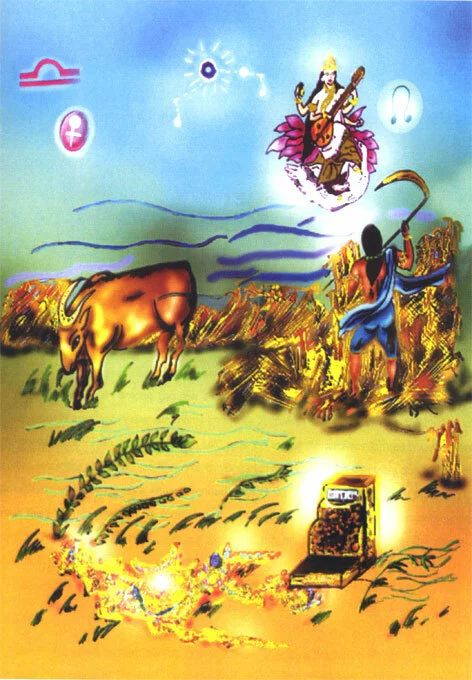


 Grass
Swati is symbolized by a
Grass
Swati is symbolized by a 

